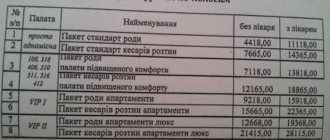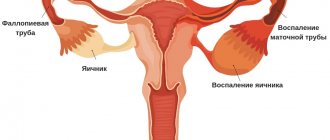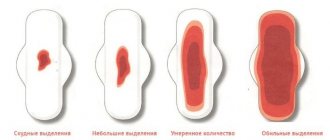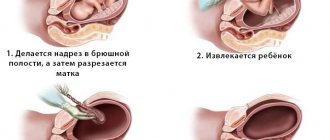Indications
Most often, a caesarean section is performed if the cervix does not dilate for a long time.
This decision is made by the obstetrician-gynecologist, which he voices to the woman in labor.
The woman, in turn, must agree or refuse, and also sign the appropriate document, which will reflect her answer. There are other cases when such measures are simply necessary:
- Possible uterine rupture. This can happen for a number of reasons, including a large fetus, prolonged labor, as well as previous cesarean section. In the latter case, the gap will be at the seam site.
- Premature placental abruption. The diagnosis is dangerous for both the mother and the fetus; moreover, this can happen at any time. Therefore, it is important to make urgent decisions about delivery.
- Fetal hypoxia - lack of oxygen occurs during childbirth. The reason for this is the entanglement of the umbilical cord around the baby.
- Umbilical cord prolapse – unattended childbirth in this case can cause serious harm to mother and child. Most often, this situation occurs with a breech presentation of the fetus.
- Transverse presentation of the fetus. In this case, the child will not be able to come out on his own, as he lies across the uterus. This situation can be noticed even on an ultrasound, then a planned CS is prescribed, but it happens that the fetus turns over during delivery. The reason for this may be a greatly distended uterus (this can happen during repeated births).
- Narrow pelvis. An emergency CS is performed if the baby cannot pass through the mother's pelvis.
- Existing genital infections that can be transmitted to the child.
- Preeclampsia - occurs in the second half of pregnancy and is characterized by problems with the kidneys, high blood pressure, and convulsions.
- Deterioration of the mother's condition.
When is a caesarean section necessary?
A caesarean section will be mandatory for the expectant mother in the following cases:
- the woman in labor has a too narrow pelvis (natural childbirth can have a negative impact on the mother’s health, especially if the fetus is large - there is a possibility that the baby will not be able to pass through the birth canal);
- varicose veins in the vaginal area (this phenomenon threatens severe blood loss for the mother);
- gestosis (this disease is characterized by spasms, increased pressure, swelling, which is unacceptable during natural childbirth);
- a scar on the uterus (if the scar has not healed, or its condition raises doubts among doctors, a CS is prescribed, since there is a possibility of its rupture);
- the location of the placenta blocks the birth canal;
- bleeding;
- uterine rupture (in this case, immediate assistance is required, since the rupture can lead to death of the mother);
- vision problems (due to myopia or a high degree of myopia, the expectant mother risks losing her sight);
- heart disease;
- chronic diseases of the mother;
- IVF (since pregnancy is “artificial” - CS is prescribed to avoid possible complications);
- fetal hypoxia;
- unfavorable position of the fetus for natural birth (for example, the baby lies across the abdomen);
- incorrect position of the baby's head, preventing the passage of the fetus through the birth canal;
- entanglement of the fetus with the umbilical cord;
- mother's death.
Consequences of an emergency caesarean section
An emergency caesarean section can lead to a number of dangerous consequences that no experienced doctor can predict.
For a child
Consequences for the baby:
- due to the administered anesthesia, the baby may experience problems with the heart and breathing;
- encephalopathy is a dysfunction of the brain in which its tissue changes;
- problems with the sucking reflex;
- violation of the amount of hormones and protein, due to which the child may poorly adapt to the environment;
- the risk of sudden death increases;
- since the umbilical cord is cut without delay, the baby may receive less immunity from the mother;
For mother
Consequences for the expectant mother:
- spinal cord injury, as well as pain after the introduction of anesthesia;
- toxic effects on the body due to painkillers;
- problems with lactation and its possible absence;
- long recovery period;
- large blood loss, which can lead to anemia;
- pain at the suture site, which can interfere with lactation and child care;
- the risk of formation of adhesions increases;
- infection in the uterus and appendages;
- reaction to anesthesia: drop in pressure, impaired breathing and heart function;
- the next pregnancy is possible only after two years. Basically, delivery will be the same.
Contraindications for surgery
There are no contraindications as such. There are only cautions, because CS can lead to an inflammatory process.
In case of inflammation, the young mother will be prescribed a course of treatment , which is as follows:
- the woman is prescribed medications (usually antibiotics);
- bed rest is prescribed;
- a course to improve the immune system is being carried out.
Moreover, the young mother is under constant medical supervision.
They say that not a single woman has ever returned from the maternity hospital pregnant! You know this is true, right? Therefore, you should not be afraid of childbirth, because a baby is the best reward!
Here you can see detailed information about caesarean section from Dr. Komarovsky:
And here you can watch a video from an obstetrician-gynecologist about in what cases a CS is done:
If you found this article useful, recommend it to your friends. And subscribe to my updates, we have something to discuss. Bye bye!
Currently reading:
How is an emergency caesarean section performed?
If doctors have at least a little time, preparatory procedures are carried out:
- An examination is carried out for possible allergic reactions.
- The intestines are cleansed. Since there is no time to completely cleanse, the pregnant woman is given a sodium citrate solution, it prevents food from entering the respiratory tract.
- Hygiene procedures are carried out.
- A decision is made about anesthesia.
- Premediation, that is, taking analgesics, antihistamines and sedatives that relieve anxiety and enhance the effect of anesthesia.
Sometimes the preparation takes a couple of minutes, and sometimes an hour. It all depends on the condition of the fetus and the woman in labor, as well as medical indications.
This surgery is performed under general anesthesia, since epidural or spinal anesthesia acts more slowly. After general anesthesia, the woman in labor remains unconscious, and the functioning of the internal organs is monitored by devices.
The duration of the entire procedure is 30-40 minutes.
It is very important to remove the baby within the first 10 minutes of surgery.
During this time, the obstetrician-gynecologist makes a longitudinal incision in the pregnant woman’s abdomen and quickly removes the baby from there. This method gives doctors greater access to the mother's pelvis.
After this, the child’s doctors take the child, and the obstetrician applies stitches in layers. If the patient has a large blood loss, then donor blood is infused into her.
Birth certificate - how to get it and what it is needed for
Hello again, my dear readers! I think literally every pregnant woman thinks about future...
The most common abdominal operation among females is cesarean section. Usually, even during pregnancy, the doctor can determine how the baby will be born. The decision of doctors to undergo surgical delivery implies preparing the patient for a planned caesarean section, however, situations arise when during the process of delivery the woman in labor requires urgent assistance or something threatens the life of the child. In such a situation, the baby is born by emergency caesarean section.
The most common abdominal operation among females is cesarean section. Usually, even during pregnancy, the doctor can determine how the baby will be born. The decision of doctors to undergo surgical delivery implies preparing the patient for a planned caesarean section, however, situations arise when during the process of delivery the woman in labor requires urgent assistance or something threatens the life of the child. In such a situation, the baby is born by emergency caesarean section.
How the body recovers after emergency surgery
This type of delivery greatly affects the woman’s psyche.
With planned or natural labor, there is time to prepare, but in this case everything is done quickly. The recovery period is also prolonged.
In the maternity hospital:
- Take antibacterial drugs that prevent infection from entering the body.
- Treatment of seams with antiseptics.
- Changing the dressings on the seam.
The home recovery period includes:
- Three days after discharge from the hospital, refuse solid food, as bowel function is impaired and a recovery period is required.
- Do not sit down for three days, you can be in a semi-lying position.
- Do not wet the seam for a week.
- Do not take a bath for a month.
- Avoid sexual activity and lift weights for two months.
- Avoid heavy physical activity for six months.
- You can't get pregnant for 2-3 years. This is how much the body recovers.
In addition, you need to rest more, get enough sleep and walk in the fresh air. The support and help of loved ones is very important, since you should not lift heavy objects for a long time.
Any option of cesarean, planned or emergency, is not the best option for delivery. Nature intended the natural birth of a child, but there are circumstances when surgical intervention is necessary to save the lives of both. During pregnancy, you need to be prepared for anything, and if the doctor advises you to undergo surgery, then you cannot refuse, because the life and health of the baby depends on it.
What else you need to know about CS
Caesarean section is usually done no later than 39 weeks - this is the generally accepted time frame. In itself, a caesarean section is a kind of operation to “extract” a child from a woman’s body.
There are several types of cesarean section:
- planned (for medical reasons);
- emergency (transition from natural childbirth to caesarean section due to unforeseen circumstances);
- planned (the woman tries to give birth on her own, but in case of any complications a caesarean section is performed);
- at will (currently, the expectant mother has the right to insist on a CS without any contraindications).
4.1. Scheduled CS
A pregnant woman has contraindications for natural childbirth, which is why she undergoes a caesarean section. A planned cesarean section is prescribed during pregnancy. The doctors’ decision depends on the tests, the general condition of the patient, past childbirth experience and other factors.
A special feature of such births is the fact that the doctor may recommend not setting a specific date for the operation, but waiting for the start of natural labor (to prevent the baby from being premature). Once labor begins, the woman will be “operated on.”
But there are cases when a planned birth is scheduled earlier than expected. A striking example is the “foot” position (breech presentation) of the fetus.
4.2. Emergency CS
You can read reviews on the Internet that some women were urgently prescribed a caesarean section during natural childbirth. That is, such an operation was not initially planned, and surgical intervention was required due to unforeseen circumstances.
The decision to perform an emergency caesarean section is made individually. For example, if during childbirth the fetus becomes entangled in the umbilical cord, the woman in labor may undergo an emergency “operation.” Or if labor is greatly weakened, the child does not receive enough oxygen, and so on.
Performing surgery and monitoring blood pressure
During a planned caesarean section, the woman is pre-examined, blood and urine tests are taken, blood pressure levels are measured and advice is given on issues of interest, for example, what medications and type of anesthesia will be used, what will happen in the postoperative period, when she will see the baby, and others. It is mandatory to take the written consent of the woman in labor for surgical intervention. Immediately before the operation, the stomach and intestines are cleaned and the groin is shaved.
During surgery, the pregnant woman's blood pressure is regularly measured.
When everything is ready, the woman is placed on the operating site, her arms and legs are fixed with grips. A catheter is placed on one arm for intravenous drug administration, and a tonometer cuff is fixed on the other arm to regularly measure blood pressure during surgery. Monitoring this indicator is important because low blood pressure, like high blood pressure, can cause complications. Before the baby is removed, the blood pressure level may be slightly increased, and after that, a redistribution of blood and load occurs, and the pressure decreases. After anesthesia, a caesarean section is performed.
The doctor makes 2 incisions: one along the anterior abdominal wall, the second through the uterus. They can be transverse or longitudinal. After gaining access to the uterine cavity, amniotic fluid is sucked out and the baby is removed. While the nurse and neonatologist examine the baby, the woman's placenta is manually removed, stitches are placed, and a drug is injected to contract the uterus.
Reasons for surgery
Emergency surgical intervention is carried out during natural childbirth. In many cases, the doctor and patient are unaware of possible complications.
The specialist should warn the woman that natural childbirth does not always proceed smoothly. Sometimes problems arise. To minimize the negative consequences for the child’s health, the woman is sent for urgent surgery. The following indications for emergency caesarean section are distinguished:
- absolute reasons;
- relative factors.
Both groups can be established during pregnancy. If a woman has a history of various chronic ailments, the doctor warns about the possibility of surgical intervention. Sometimes problems are discovered during labor. In this case, the patient is transferred from the delivery room to the operating room. Before this, the doctor explains what consequences the woman’s further independent actions may cause. To understand the dangers of the reasons for the operation, it is necessary to analyze them separately.
Absolute reasons
There are many indications for elective caesarean section. For many women, emergency surgery is prescribed suddenly. But sometimes the doctor discusses possible surgery before labor begins. If a woman decides to give birth on her own, all conditions must be provided to quickly transfer the process to the operating room.
Absolute causes are considered to be various pathologies in a woman’s condition. For many patients, surgery is recommended due to problems with the discrepancy of the pelvic bones. Normally, the pelvis expands as labor approaches. This is necessary to move the baby to the lower uterus. The displacement occurs due to the moving apart of the bones and the work of the hormone oxytocin. The upper part of the uterus begins to contract. The pressure on the fetus increases. Gradually the child moves down. If the pelvic bones do not move apart, the child remains in position. The action of the hormone causes the walls of the uterus to contract. Natural labor begins. Under pressure, the fluid in the child’s lungs begins to gradually drain out. The fetus begins to breathe pulmonaryly. Lack of oxygen leads to hypoxia. The child begins to choke. To quickly give the fetus access to air, it is necessary to perform surgery.
Caesarean section is also recommended for large fetal weights. A child’s normal body weight should not exceed 3.5 kg. But many mothers do everything to ensure that the child quickly gains weight before giving birth. The error occurs due to the peculiarities of intrauterine development of the fetus. Until the seventh month, the formation of limbs and various systems in the fetus occurs. From the eighth month, a fully formed baby begins to actively gain weight. Pregnant women continue to eat as usual during this period. The amount of nutrients supplied to the fetus exceeds the norm. The child is getting big. If, during ultrasound diagnostics, the estimated weight of the fetus exceeds 4 kg, the doctor suggests surgery. Some women believe that they can cope on their own. This leads to an emergency caesarean section.
The operation is carried out due to the weak progress of the child along the birth canal. The fetus is experiencing a lack of oxygen. Only emergency intervention from doctors can save a child’s life.
Additional reasons
An emergency caesarean section is also prescribed for sudden loss of amniotic fluid. The water may break suddenly due to the low location of the placenta. This pathology is often detected during a routine ultrasound examination in the early stages of pregnancy. To increase the gestation period, a woman is fitted with a pessary. It prevents the cervix from opening prematurely.
But sometimes a woman notices drops of liquid on her underwear. You can determine the nature of the liquid yourself. For this purpose, water leakage tests are used. If the test shows a positive result, you must urgently call a doctor. In this case, surgery is performed.
A dangerous disease related to the absolute causes of surgical intervention is placental abruption. This problem can lead to the death of mother and child.
The danger of placental abruption for the fetus is the cessation of the delivery of oxygen and nutrients. Poor circulation is also observed. The mother's life is threatened by sudden bleeding. Blood begins to leave the area of the vessels located at the site of detachment. It is impossible to fix the problem. Only an emergency caesarean section can help.
The doctor should suggest a planned operation if the baby is not positioned correctly in the womb. Before birth, the fetus must turn its head over. The legs should be pointing straight up. The fetus cannot always take this position. Adopting the correct position is also not the key to a successful natural birth. The fetus may not develop properly when contractions begin. If he does not take the position necessary for childbirth, surgery should be performed.
Weak contractile activity of the uterus is also considered a pathology. It appears due to a lack of the hormone oxytocin or the genetic predisposition of the woman in labor. The long process of dilation of the cervix is fraught with the complete release of fluid from the baby’s lungs. He may die before pushing begins. The condition of the fetus is monitored using a special device that monitors the heart rate. If it decreases, a decision is made by the doctor within a short time.
Relative factors leading to sudden surgery
Recommendations for caesarean section can be relative. It is believed that these pathologies have no obvious danger to the health of the mother and fetus. But sometimes they can lead to unexpected complications. An emergency caesarean section can be performed for pathologies such as:
- the presence of endocrinological pathologies;
- infections of the reproductive system;
- cardiovascular diseases;
- oncological neoplasms;
- myopic eye disease;
- bearing several fruits.
Diabetes mellitus is the reason for recommended cesarean section. Emergency intervention is carried out if the risk of large blood loss increases. Bleeding may occur due to disruption of the vascular system. Vascular tissue of a healthy person has properties such as flexibility and elasticity. Endocrine disease causes the destruction of your own collagen. Against this background, the destruction of individual sections of vascular tissue occurs. When contractions occur, blood pressure rises. The weakened tissue cannot withstand the blood pressure and collapses. Through the gap, blood enters the cavity. If the patient's contractions are accompanied by severe ruptures of the vascular tissue, it is necessary to perform an emergency operation by cesarean section.
Problems may also arise if there is a history of genital infections. Most of these diseases are caused by bacteria. Pathogenic microorganisms cause changes in the vaginal microflora. If there are injuries on the child’s body or he begins to actively move, it is recommended to undergo surgery. Otherwise, the fetus may become infected from the mother. You should not think that such infections are not dangerous for the baby’s health. After birth, the baby's skin is gradually renewed. Peeling causes the formation of microcracks. Through them, the bacteria penetrates the child's body. Further development of the infection leads to a decrease in immune defense. The child constantly suffers from various diseases.
Other indications for surgery
Cardiovascular pathologies are diverse. A recommendation for a caesarean section occurs in the presence of high blood pressure and problems with the heart muscle. Both diseases can worsen dramatically during labor. A rapid increase in pressure is dangerous due to sudden bleeding. It can also harm the fetal nervous system. If the doctor does not perform an emergency caesarean section, the woman may die.
Planned intervention should be carried out in the presence of oncological neoplasms. Surgery is also necessary for patients with uterine corpus fibroids. Neoplasms of various etiologies develop due to a violation of the structural composition of the tissue. Abnormal cells begin to actively multiply. The danger arises when the surface of the neoplasm is damaged during natural childbirth. Damaged tissue may rupture under pressure. If the doctor believes that the risk of such damage is high, the woman in labor is referred for emergency surgery.
The presence of progressive myopia is considered a relative reason for cesarean section. Myopia can be congenital or acquired. Emergency intervention is often carried out against the background of acquired myopia. This vision pathology appears due to problems with the optic nerve, lens and retina. If childbirth results in retinal detachment, the woman needs urgent surgical intervention.
Emergency surgery is also required for multiple pregnancies. The presence of two or more fruits shortens the gestation period. An increase in the weight of the fetus causes increased pressure on the lower part of the uterine cavity. To avoid possible complications, you should resort to elective surgery. If a woman decides to give birth on her own, the operating room should be ready. Any change in the children's vital signs is considered a reason for an emergency caesarean section.
Indications for planned caesarean section - everything is going as planned
A planned cesarean section is indicated when the fetus lies transversely, with an anatomically narrow pelvis of 2-4 degrees in a woman, with the failure of a postoperative scar on the body of the uterus after a previous cesarean section, with placenta previa, which was revealed by ultrasound, with fetoplacental insufficiency, with severe myopia, which accompanied by changes in the fundus and thinning of the retina.
If a boy is expected to be born, but he has a breech presentation, then this is a reason for a cesarean section due to the fact that a natural birth may cause injury to the scrotum.
Another compelling argument is pregnancy with complications after a period of infertility or in cases of in vitro fertilization. Cesarean section is used to minimize the risk during the birth of the baby.
If a woman suffers from diabetes, heart defects, kidney diseases, severe hypertension, then the obstetrician-gynecologist agrees with the therapist on the method of childbirth.
A planned operation is performed at 38 weeks of pregnancy . By this time, the child is already fully formed and ready to be born. If there are strong indications - for example, Rh-conflict with a severe form, the development of severe hypoxia that cannot be treated, then the operation is performed earlier.
The expectant mother is hospitalized in the observation department for pregnant women in the maternity hospital. The date of surgery is determined after examinations such as blood tests, ultrasound, cardiotocography.
A planned caesarean section has the main advantage - you can fully prepare . The day before the operation, the pregnant woman is prescribed a light diet, which consists of a light breakfast, lunch, and for dinner she is allowed to drink only tea with sugar. After the shower procedures, the woman is given a cleansing enema, which is given again in the morning. Such measures are taken to prevent intestinal paresis from developing, the possibility of which appears after surgery due to stagnation of fecal matter. Microbes that are in the intestines are able to enter the abdominal cavity through the intestinal wall, leading to obstetric peritonitis. This route of infection of the peritoneum is very common, although there are others.
To ensure that the expectant mother gets a good night's sleep before the operation, she is prescribed a safe sleeping pill at night.
And when planning a caesarean section, the woman is adjusted psychologically. With this attitude, the expectant mother and baby will be subject to less stress, which will have a beneficial effect on the operation itself and on the rehabilitation period after the operation.
Nutrition for mom after cesarean
The diet after surgery should be given special attention. After all, it is proper postpartum nutrition that contributes to the rapid recovery of the mother’s body, and through breastfeeding, the baby.
After giving birth, the mother must follow a strict diet. On the first day, doctors allow you to drink still mineral water. Yes - only on the second day. You can indulge yourself in porridge, boiled meat, broth, baked apples, crackers, tea and kefir. But fresh bread is not allowed - it is harmful to the intestines. A full-fledged “feast” will begin on the third day - then you can have a good breakfast, lunch and dinner. Naturally, you need to exclude those foods that doctors do not recommend during breastfeeding.
At home, try to eat more eggs, meat, liver - these foods contain zinc. You can and should include more vitamin C in your diet - eat currants and cauliflower. Eat more iron - yolks, spinach.
Diagnosis and treatment
Endometriosis is diagnosed by laparoscopy and hysterosalpingography, x-ray of the fallopian tubes and uterus. Ultrasound diagnostics in this case may not provide reliable information.
You need to pay special attention to symptoms such as: severe pain during menstruation, heavy bleeding, spotting before or after the menstrual period, pain in the pelvis, prolonged inability to conceive.
Endometriosis is treated with hormonal therapy or surgery. If the disease leads to infertility, the woman may undergo hormonal therapy, intrauterine insemination, or cause artificial menopause.
Recent research in this area has shown that intrauterine insemination is not very effective. After all, to achieve pregnancy with endometriosis, high-quality eggs are necessary, so now I most often offer women the procedure of in vitro fertilization.
Impending or incipient uterine rupture
Uterine rupture is an injury that is extremely rare. This condition can be caused by a discrepancy between the size of the fetus and the mother’s pelvis (clinically narrow pelvis), as well as previous operations (cesarean section, operations to remove myomatous nodes). Contractions become frequent and very painful, pain in the lower abdomen becomes constant, and the uterus does not relax between contractions. When a rupture occurs, signs of acute blood loss are detected in mother and fetus.
In this case, only a timely operation can save the life of the mother and fetus.










